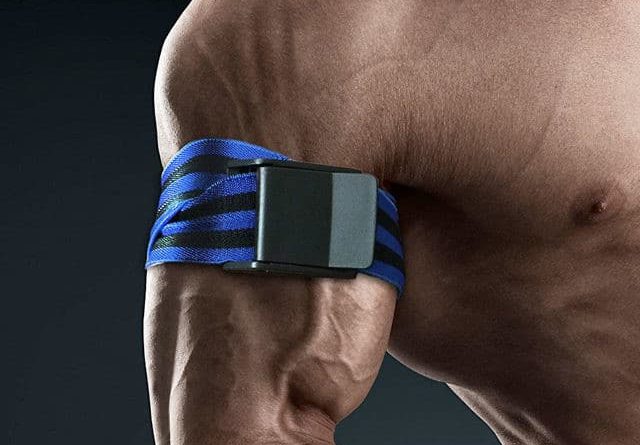What is Blood Flow Restriction Occlusion Training?
As a strength coach and sports nutritionist, my clients constantly ask for ways to build serious muscle without the brutal wear and tear of lifting heavy year after year. For a long time, the options were limited. But what if you could trigger significant muscle growth using lighter weights? That’s the promise of blood flow restriction (BFR) training, also known as occlusion training, and it’s a game-changer.
Many dedicated bodybuilders and powerlifters eventually face a common enemy: beat-up joints. When your joints scream every time you approach a heavy barbell, it’s easy to feel like your mass-building days are over. But with occlusion training, that’s not the case. Studies show this technique can spark muscle hypertrophy using loads as light as 20-40% of your one-rep max (1RM).
This guide breaks down the science behind how BFR works, how to do it safely, and how to add it to your routine to build quality muscle while giving your joints a much-needed break.
Disclaimer: This article is for informational purposes only and is not meant to treat or diagnose any condition. It is recommended that you speak with your doctor before starting any exercise program, changing your daily nutrition, or adding any supplements to your regimen.
Table of contents
Key Takeaways
- Build More with Less: Occlusion training allows you to stimulate muscle growth using weights as light as 20-50% of your max, reducing stress on joints and tissues.
- Metabolic Stress is Key: The technique works by trapping blood in the muscle, creating a low-oxygen environment and a buildup of metabolic byproducts that signal your muscles to grow.
- Safety First: Proper cuff placement and pressure are critical. You should feel a tightness of about 7 out of 10, but never numbness or pins and needles. It is not recommended for individuals with vascular issues or high blood pressure.
- Use the Right Tools: For best results and safety, use dedicated BFR cuffs like those from Smart Cuffs or B Strong, which allow for more accurate pressure control than simple elastic bands.

Restrict Blood for Maximal Gains?
Occlusion training sounds intense because it is. The goal is to strategically restrict venous blood flow from a working muscle while still allowing arterial blood to flow in. This is done by placing specialized bands, wraps, or cuffs at the top of your arms or legs.
High-quality pneumatic systems like Smart Cuffs or B Strong offer precise pressure control, which is ideal for safety and effectiveness. While basic occlusion training cuffs are a good starting point, the key is proper application. The wrap should be tight, but not dangerously so. A good guideline is a perceived tightness of 7 out of 10, but you should never feel numbness or a “pins and needles” sensation.
This technique tricks your body into thinking it’s lifting heavy. While traditional bodybuilding requires lifting at 65% or more of your 1RM to build mass, BFR training can produce size and strength gains with as little as 20-50% of your max. This creates an insane pump and has been shown to increase anabolic growth factors like IGF-1 and growth hormone.
*A common-sense warning I feel compelled to add: DO NOT attempt to occlude blood flow around your neck, torso, or genitalia. This training is only for the limbs.
How Does Occlusion Training Work?
Occlusion training works by creating massive amounts of metabolic stress in the muscle. By trapping blood, you prevent metabolic byproducts like lactate from being cleared away, which sends a powerful signal for muscle adaptation and growth.
Our bodies have two main muscle fiber types: Type 1 (slow-twitch) for endurance and Type 2 (fast-twitch) for strength and power. Heavy lifting is effective because it recruits Type 2 fibers. The low-oxygen environment created by BFR forces your body to recruit these powerful Type 2 fibers much earlier and with a much lighter weight.
This method is most effective with single-joint exercises where you can maintain control. Some of the best options include:
- Biceps Curls
- Triceps Pushdowns
- Leg Extensions
- Leg Curls
Your First BFR Workout Protocol
A BFR workout should be short and intense, typically lasting no more than 10-15 minutes for a given muscle group. Only train your arms or legs in a single session, not both. To get started, follow this scientifically validated “30-15-15-15” protocol:
- Secure the Cuffs: Place the cuffs “high and tight” on your upper arms or upper thighs.
- Select Your Weight: Choose a very light weight, around 20-40% of your 1RM.
- Set 1: Perform 30 repetitions, then rest for 30 seconds.
- Sets 2, 3, and 4: Perform 3 sets of 15 repetitions, with only 30 seconds of rest between each set.
- Keep Cuffs On: Do not loosen or remove the cuffs until all four sets are complete. This is crucial for trapping the blood and creating metabolic stress.
Is Occlusion Training Safe?
When performed correctly, occlusion training is surprisingly safe for healthy individuals. Renowned BFR researcher Dr. Jeremy Loenneke has highlighted that the risk of issues like muscle damage or blood clots is very low when protocols are followed, largely because the loads are light and the restriction is only applied for a few minutes at a time.
The entire protocol should only last 10-15 minutes, which is not long enough to cause damage to the limbs. However, this method is not for everyone.
Important: You should NOT use BFR training if you have a history of vascular issues. This includes high blood pressure, deep vein thrombosis (DVT), varicose veins, or any cardiac disease. Always consult with a physician before starting a new training protocol.
Listen to your body. Occlusion training is uncomfortable by nature, but it should not be excruciating. If you feel your limb getting numb or experience sharp, severe pain, stop immediately and remove the cuffs. The goal is a deep burn and an incredible pump, not injury.
References:
- Cook, C. J., et al. (2013). Three weeks of occlusion training can improve strength and power in trained athletes. International Journal of Sports Physiology and Performance. 9(1), 166-72.
- Park, S. Y., et al. (2015). Low intensity resistance exercise training with blood flow restriction: insight into cardiovascular function, and skeletal muscle hypertrophy in humans. The Korean Journal of Physiology & Pharmacology. 19(3), 191-196.
- Vanwye, W. R., et al. (2017). Blood flow restriction training: implementation into clinical practice. International Journal of Exercise Science. 10(5), 649-654.
FAQs About Occlusion Training
Can I use knee wraps or regular elastic bandages for BFR?
While you can use basic wraps, it’s not ideal. The biggest risk is applying inconsistent or excessive pressure, which can be ineffective or dangerous. Purpose-built BFR cuffs, especially pneumatic ones that measure pressure, are a much safer and more reliable option. They ensure you’re occluding venous flow without cutting off arterial supply.
How often can I do occlusion training?
Because it’s less mechanically stressful, you can use BFR more frequently than heavy lifting. Most guidelines suggest performing BFR 2-3 times per week per muscle group. It’s an excellent tool to use as a “finisher” after your main lifts or on active recovery days to get in extra volume without taxing your joints.
Does BFR hurt?
BFR is not comfortable. The buildup of metabolic stress creates a significant burning sensation and an intense pump, which can be painful for some. However, it should not cause sharp, shooting pain or numbness. If it does, the cuffs are too tight. The discomfort should be contained to the muscle itself.
Can you use BFR for chest, back, or shoulders?
No, you cannot directly use occlusion training for the torso muscles. BFR is designed to be applied to the limbs (arms and legs), where a cuff can be safely placed at the most proximal point to restrict blood flow to the muscles below it. There is no safe or effective way to apply this technique to the chest, back, or deltoids.


*Disclosure: This article may contain affiliate links or ads, which means we earn a small commission at no extra cost to you if you make a purchase through these links. These commissions help support the operation and maintenance of our website, allowing us to continue producing free valuable content. Your support is genuinely appreciated, whether you choose to use our links or not. Thank you for being a part of our community and enjoying our content.
PLEASE CONSIDER SHARING THIS ON YOUR SOCIAL MEDIA TO HELP OTHERS LEARN MORE ABOUT THIS TOPIC.





